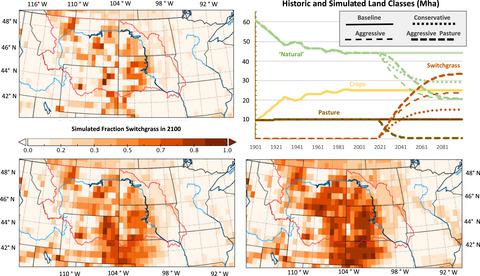当前位置:
X-MOL 学术
›
GCB Bioenergy
›
论文详情
Our official English website, www.x-mol.net, welcomes your feedback! (Note: you will need to create a separate account there.)
Land management and climate change determine second‐generation bioenergy potential of the US Northern Great Plains
Global Change Biology Bioenergy ( IF 5.6 ) Pub Date : 2020-05-13 , DOI: 10.1111/gcbb.12686 Katelyn A. Dolan 1 , Paul C. Stoy 1, 2 , Benjamin Poulter 3
Global Change Biology Bioenergy ( IF 5.6 ) Pub Date : 2020-05-13 , DOI: 10.1111/gcbb.12686 Katelyn A. Dolan 1 , Paul C. Stoy 1, 2 , Benjamin Poulter 3
Affiliation

|
Bioenergy with carbon capture and storage (BECCS) has been proposed as a potential climate mitigation strategy raising concerns over trade‐offs with existing ecosystem services. We evaluate the feasibility of BECCS in the Upper Missouri River Basin (UMRB), a landscape with diverse land use, ownership, and bioenergy potential. We develop land‐use change scenarios and a switchgrass (Panicum virgatum L.) crop functional type to use in a land‐surface model to simulate second‐generation bioenergy production. By the end of this century, average annual switchgrass production over the UMRB ranges from 60 to 210 Tg dry mass/year and is dependent on the Representative Concentration Pathway for greenhouse gas emissions and on land‐use change assumptions. Under our simple phase‐in assumptions this results in a cumulative total production of 2,000–6,000 Tg C over the study period with the upper estimates only possible in the absence of climate change. Switchgrass yields decreased as average CO2 concentrations and temperatures increased, suggesting the effect of elevated atmospheric CO2 was small because of its C4 photosynthetic pathway. By the end of the 21st century, the potential energy stored annually in harvested switchgrass averaged between 1 and 4 EJ/year assuming perfect conversion efficiency, or an annual electrical generation capacity of 7,000–28,000 MW assuming current bioenergy efficiency rates. Trade‐offs between bioenergy and ecosystem services were identified, including cumulative direct losses of 1,000–2,600 Tg C stored in natural ecosystems from land‐use change by 2090. Total cumulative losses of ecosystem carbon stocks were higher than the potential ~300 Tg C in fossil fuel emissions from the single largest power plant in the region over the same time period, and equivalent to potential carbon removal from the atmosphere from using biofuels grown in the same region. Numerous trade‐offs from BECCS expansion in the UMRB must be balanced against the potential benefits of a carbon‐negative energy system.
中文翻译:

土地管理和气候变化决定了美国北部大平原的第二代生物能源潜力
有人提议将具有碳捕获和存储的生物能源(BECCS)作为一种潜在的气候缓解策略,引起人们对与现有生态系统服务之间的权衡取舍的担忧。我们评估了密苏里州上游流域(UMRB)的BECCS可行性,该地区具有多种土地利用,所有权和生物能源潜力。我们开发土地利用变化方案和柳枝((Panicum virgatumL.)作物功能类型,可用于陆面模型来模拟第二代生物能源生产。到本世纪末,UMRB上的年平均柳枝production产量为60至210 Tg干质量/年,并且取决于温室气体排放的代表性浓度途径和土地利用变化的假设。在我们简单的阶段性假设下,这将导致研究期间的总总产量为2,000–6,000 Tg C,只有在没有气候变化的情况下才可能进行上限估算。柳枝yield产量随平均CO 2浓度和温度升高而降低,表明大气CO 2升高的影响由于它的C4光合作用途径而很小。到21世纪末,假设完美的转换效率,每年收获的柳枝stored中存储的潜在能量平均为1-4 EJ /年,假定当前的生物能效率,则年发电量为7,000–28,000 MW。确定了生物能源与生态系统服务之间的权衡,包括到2090年土地利用变化在自然生态系统中累积的直接直接碳蓄积1,000–2,600 TgC。生态系统碳储量的总累积损失高于潜在的300 TgC。同一时间段内该地区最大的单个发电厂的化石燃料排放量,相当于使用同一地区生长的生物燃料从大气中潜在去除的碳。
更新日期:2020-05-13
中文翻译:

土地管理和气候变化决定了美国北部大平原的第二代生物能源潜力
有人提议将具有碳捕获和存储的生物能源(BECCS)作为一种潜在的气候缓解策略,引起人们对与现有生态系统服务之间的权衡取舍的担忧。我们评估了密苏里州上游流域(UMRB)的BECCS可行性,该地区具有多种土地利用,所有权和生物能源潜力。我们开发土地利用变化方案和柳枝((Panicum virgatumL.)作物功能类型,可用于陆面模型来模拟第二代生物能源生产。到本世纪末,UMRB上的年平均柳枝production产量为60至210 Tg干质量/年,并且取决于温室气体排放的代表性浓度途径和土地利用变化的假设。在我们简单的阶段性假设下,这将导致研究期间的总总产量为2,000–6,000 Tg C,只有在没有气候变化的情况下才可能进行上限估算。柳枝yield产量随平均CO 2浓度和温度升高而降低,表明大气CO 2升高的影响由于它的C4光合作用途径而很小。到21世纪末,假设完美的转换效率,每年收获的柳枝stored中存储的潜在能量平均为1-4 EJ /年,假定当前的生物能效率,则年发电量为7,000–28,000 MW。确定了生物能源与生态系统服务之间的权衡,包括到2090年土地利用变化在自然生态系统中累积的直接直接碳蓄积1,000–2,600 TgC。生态系统碳储量的总累积损失高于潜在的300 TgC。同一时间段内该地区最大的单个发电厂的化石燃料排放量,相当于使用同一地区生长的生物燃料从大气中潜在去除的碳。


























 京公网安备 11010802027423号
京公网安备 11010802027423号